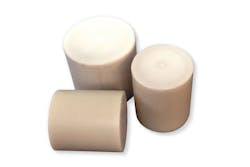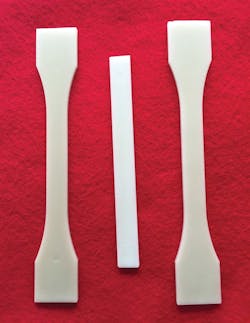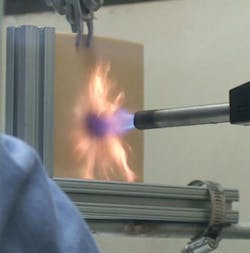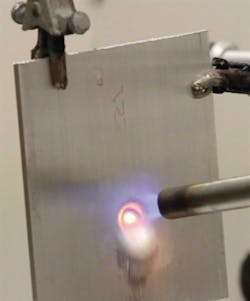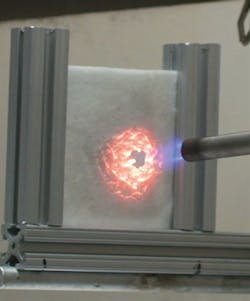Glass-reinforced PVDF with ultra-high modulus
Polyvinylidene fluoride (PVDF), first commercialized in 1964, is considered a high-performance fluoropolymer with versatile properties and performance features. Among a large set of useful properties, PVDF is broadly chemical resistant, highly abrasion resistant, creep resistant (FN-2) and stable to intense ultraviolet sunlight for many years, and it supports a 150˚C relative thermal index rating (FN-1).
With these properties, designers continue to find new applications for PVDF in a growing number of applications. The first major markets for PVDF were fluid handling components for strong acids and halogen environments; insulations and jacketing for high-temperature and flame-resistant wire and cables; and long-life architectural finishes for outdoor, exposed metal building components. In recent years, PVDF has experienced large growth in oil exploration piping, solar panel components, water filtration equipment, food processing equipment subjected to aggressive cleaning agents, and foamed flame-resistant insulations for aircraft interiors.
Compared to many other polymers developed during the same time period, little work has been accomplished related to reinforcing PVDF to increase its strength and stiffness for those applications in which plastics continue to find design niches traditionally served by metals. PVDF compounds using carbon fiber were developed years ago, and they provide novel performance improvements in strength and tolerance stability, but a higher product cost is associated with this technology.
Many engineering polymers and commodity polymers such as ABS, nylon, polypropylene, PPS, acetyl, PEEK, polysulfone and PEI have all been offered in glass-filled versions to increase stiffness and help with holding tolerances in molding. For various reasons, PVDF glass-filled technology has not been highly developed. Recently, Arkema Inc. began a technical program to develop glass-filled PVDF for applications in which the end user requires a stiffer, stronger and higher temperature-resistant fluoropolymer material and in which other properties of chemical resistance, abrasion resistance, sunlight resistance and flame resistance are important for final product performance. The Kynar UHM fluoropolymer series is the resulting product line that combines PVDF with glass fibers.
Table 1. Property comparisons of standard PVDF homopolymer and glass fiber-filled PVDF
Image 2. Injection-molded tensile bars made with glass-reinforced PVDF
Processing of reinforced PVDF compounds
Because of the general ease of processing associated with PVDF – where typical conditions and equipment used in polypropylene, nylon and PVC processing can be used, the compounding of glass fibers into the PVDF – is not unusually difficult. In the same vein, producing injection-molded parts, such as pump components, fittings, valves or dump tower packing, or extruded shapes, such as rods, sheets or pipes, is not considered more difficult than other glass-filled products. Production rates are mostly in line with standard expectations for virgin PVDF. Images 1 and 2 show examples of extruded and injection-molded glass fiber-reinforced PVDF products.
Knowing that keeping the processing temperatures lower is a safer procedure with glass-filled fluoropolymers, the glass-reinforced PVDF products are manufactured with relatively high melt flow rate PVDF base resin. The addition of the glass fiber drives up the viscosity of the polymer blend, but the melt flow rate of the recommended polymer composite still rests in the range at which the product can be injection molded at temperatures below 210˚C and extruded at or below 240˚C.
Physical & mechanical property measurements
By varying the PVDF base polymer molecular structure through reaction control or copolymerization with another monomer, such as hexafluoropropylene (HFP), many standard physical and mechanical properties can be tailored, and these initial properties can be further manipulated by changing the overall percentage of glass-fiber filler. Because the performance initially targeted with the glass-reinforced PVDF series was increased flexural modulus, increased tensile strength and a heat deflection temperature of more than 150˚C – all while maintaining a reasonable amount of ductility – different levels of glass addition were considered.
Following a battery of testing with the known initial mechanical property targets, a glass type and a loading was selected as the baseline to build the product line. The selection of the glass fiber “type” and the “percent loading” of the glass fiber are of high importance for different reasons. The selection of the glass type highly influences the chemical resistance retention in very difficult chemicals often associated with PVDF utilization. If the glass is compounded into the PVDF at a high enough concentration, it can become a limiting factor in the chemical service rating. The percent loading of the glass fibers into the PVDF base is a major influence on how high the mechanical properties are increased in comparison to the neat resin. Table 1 shows the difference in properties of Kynar 720, an all-purpose molding and extrusion homopolymer PVDF grade, and Kynar UHM 6020-20, a PVDF composite designed to significantly increase the stiffness, tensile strength and deflection temperature of a neat PVDF homopolymer.
As expected, the glass fiber-filled PVDF product shows substantially higher tensile strength (120 MPa), flexural modulus (6,600 MPa), and heat deflection temperature at high-load force (159°C). These properties matched the original target goals, so this product became the baseline for the glass fiber-filled PVDF series. By varying the loading percentage of glass, these numbers could be increased or reduced with resulting changes in ductility. Increased ductility can also be achieved by loading glass into a PVDF of higher molecular weight or into a PVDF copolymer, such as one made from vinylidene fluoride and hexafluoropropylene.
Flame testing
Previous work with other PVDF and glass combinations was presented showing a unique performance related to flame burn-through resistance (FN-3). With this in mind, some tests were conducted using a propane torch and 18-inch thick plaques made from aluminum, glass fiber, PVDF homopolymer and PVDF homopolymer plus a glass-fiber compound.
Image 3. The test of a torch applied to the PVDF materials
The torch was held two inches from a secured plaque of each material (see Image 3) with continuous burning, and the results of the time to burn through to the other side of the sample were recorded (see Table 2). Image 3a shows the final results of the burn through of the aluminum panel, and Image 3b shows the final results of the burn through of the glass mat.
Image 3a. Aluminum burn through at 85 seconds
It is an interesting result that a 18-inch aluminum panel took 85 seconds to burn completely through from the constant torch exposure. A 18-inch section of fiberglass required only 3 seconds, and a 18-inch plaque of PVDF homopolymer took 28 seconds to burn through. The glass fiber-filled PVDF in a 18-inch plaque finally burned through after 430 seconds. Samples of the glass fiber-filled PVDF, when made slightly thicker, burned for more than 15 minutes without burning through, showing that, as this combination becomes thicker, its resistance to flame effects became much greater. In fact, though it was not measured, a long time passed before the heat even transferred to the back side of the plaque in the test. This was shown in earlier published works related to PVDF foams with the addition of glass mats (FN-4).
Image 3b. Glass mat burn through at 3 seconds
Suggested applications for glass-reinforced PVDF
PVDF already is used prominently in the chemical processing, petrochemical recovery, mining, electrical wiring and connections, aircraft, military, ship, automotive, solar energy, water processing and food processing industries. Articles currently already made of neat PVDF that could also be enhanced by glass-filled composites are pipes, fittings, valves, nozzles, clamps, fluid connectors, tapes/films, pump parts, dump tower packing, tanks, wires and connectors, and filaments.
Table 2. Burn-through testing results of aluminum, PVDF homopolymer, glass mat and glass-reinforced PVDF.
This new series of products is now highly flame resistant, strong, stiff and creep resistant even at elevated temperatures. With these properties and the appropriate research and development, pump assemblies could maintain high-temperature service conditions better than ever. Other possibilities are:
- Plastic valves designed to be turned on and off frequently without distortion
- Tower packing that does not sag readily over time
- Cable insulations exposed to high heat that do not thin out or drip off the protected cable
- Strong filaments with high chemical resistance that can be used to wrap products for high-pressure resistance
- Plastic products designed for prolonged system integrity and safety in the event of direct fire exposure
Clamping devices that can apply high force to the system they are intended to hold.
References
1. FN-1. Uddin, Tofique. Underwriters Laboratories Letter to Arkema, File E54699. April, 27, 2013.
2. FN-2. R. Hanselka, R. Williams, M. Bukay. "Materials of Construction for Water Systems – Part 1: Physical and Chemical Properties of Plastics." Ultrapure Water 4 (5), 45-60 ( July/ August 1987).
3. FN-3, FN-4. Sherman, Lilli Manolis. "PVDF Latex Foam Composites Provide High Flame Resistance." Plastics Technology Magazine, November 2002.
David A. Seiler Sr. is the business manager industrial/ global advisor of fluoropolymers, Arkema Inc., with 33 years of experience in the fluoropolymer and polyamide industry. He holds a Bachelor of Science in chemical engineering from Penn State University and is an active member of the American Society for Testing and Materials (ASTM), American Society of Mechanical Engineers – Bioprocessing Equipment, Semiconductor Equipment and Materials International F57, International Code Council, and National Fire Protection Association.
Gary Dennis is sales manager for Arkema Inc. Fluoropolymers. He has 30 years of experience in the plastics industry and has written numerous articles on technical polymer markets and applications.
Saeid Zerafati is a principal scientist with Arkema Inc. in King of Prussia, Pennsylvania. He has worked for Arkema for more than 22 years, handling the new product development and applications in the fluoropolymer and plastic additives divisions. Zerafati has Master of Science and doctorate degrees in mechanical engineering with concentration on polymer processing and a second master’s degree in polymer science and engineering with concentration on polymer physics. He has more than 20 U.S. and international patents and is the author of numerous articles.
